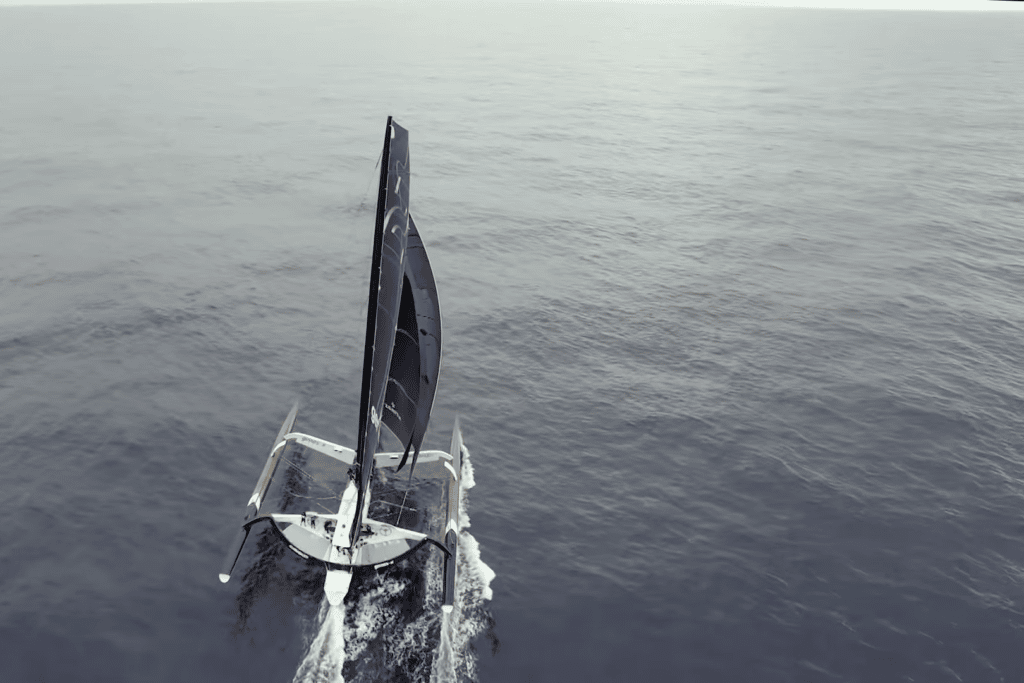
At the 2014 E Scow Nationals there was an epic crash at the weather mark that Sean Fidler captured on film from the drone he was flying as part of the event coverage through his company, Regatta Aerials. “We were busy going between parties and the dinner that evening, but we said, let’s edit that out really quickly, throw it out and see what happens. That night there were something like 10,000 hits already.” Here’s his take on the convergence of sailing and drone photography.
Are there many people are providing drone coverage of sailing events?
There are probably a dozen pretty well-known guys out there who are doing this. I know there are guys in Florida, on the East Coast, in Europe. There’s a gray area right now, because you have to have the FAA license to do commercial work. And this is technically commercial work if you’re paid. So you can do it just for the fun of it, for sure. But as the FAA tightens up and that regulation expands, you’re going to need to get a certification, and that’s probably why a lot of these guys are kind of under the radar.
What challenges does drone photography face?
We have to find a way to make it affordable. The drone itself is inexpensive. The drone we used for the Blue Chip Regatta, with batteries, is about $2,000. It shoots a 4K flat image, so no more guppy lens, like a GoPro. If you look at the video here from the Blue Chip, you’ll see that, and compare it to last year’s video, so the sail shape you’re seeing are true. Our Achilles’ heel is just what the 4G signal is at whatever particular part of the lake we’re on and other interference issues, etc.
Tell us about the drone controls.
There are three control levers—the right controller, which is the x and y axis, right and left x, up and down y. The left controller is for yaw, which is side to side, and throttle or altitude left and right. You also have gimbal pitch, so you can have the gimbal set up to shoot straight forward or all the way down or anywhere in between in that 90 degree range.
How do you compensate for the wind? Isn’t it like being in a current up there?
There are two modes in most drones or quadcopters. One is a GPS lock mode, which, if you take your hands off the controller, will lock and keep the drone exactly in that spot. But that’s difficult when you’re trying to follow a moving sailboat. So then you go to the attitude mode, where it holds a level attitude but if you let go of the controls, it will drift downwind like a balloon. So downwind, I use the attitude mode because I can be hands off and just slightly correcting the drift of the drone downwind. Generally, boats are as fast as the wind speed, so I almost have to do no work. It’s actually easier downwind. Upwind, I use the GPS mode, so if I go near a mast or have a problem, I can go to the stick, give it power and go above, and I know it’s going to hold its position. We flew the drone here last year and there were gusts up to 30 knots one day—no problem. The stability system in the drone, its GPS hold, was enough to be absolutely stable. There’s also a sonic altimeter, which will tell how high the drone is off the water. It knows if there’s an object to the side, and it will automatically stay away from it. It’s not perfect. If you fly it 30 miles an hour into the side of a mainsail, it’s going to hit, but if something slowly comes at it, it will recognize it and stay away.
Where do you see drone coverage of events like sailboat racing going? What’s next?
I think the E Scow Blue Chip Regatta is the first time drone coverage has been streamed live. If you look at what was done, our coverage is at times as good as the America’s Cup coverage with the full helicopter. So what you have is a tremendous ability to promote your event and get people excited about it. They don’t have to wait hours or days for some video that might be edited and might be really nice.
From a technical angle, what do you want to see that’s not there yet?
More battery life. Stronger signal range.
There must be some coaching applications for this as well.
We film women’s and men’s college soccer, hovering the drone above the players. From a side dimension, you don’t have depth perception, and you can’t really see the tactics. But when the coach sees the aerial perspective, he can coach better. He can talk about position on the field better. Sailing is exactly the same thing. You can see everything. But you need a good pilot to be able to hold the drone over the sailboat consistently. You can’t just be able to follow the boat from behind. You have to be able to follow it from above, from in front, the leeward side moving sideways and the windward side. I’ve been doing this since I was 10 years old, but I’m sure there are other sailors who have been doing RC skills, and some of these young kids could probably pick up what I’ve learned in a lifetime in a couple of years.









